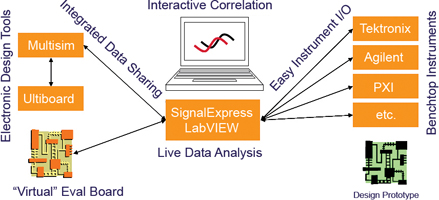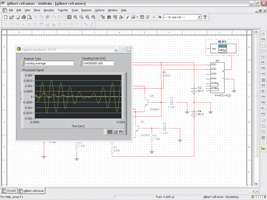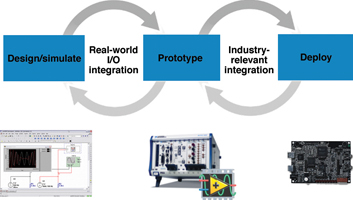
While design verification and circuit simulation are the two most essential and critical elements of the design process, engineers should not view them as distinct and unrelated stages in the development process. Most engineers recognise that integration of design and test would improve product development, but are limited by disparate tools for each phase.
For the first time in the industry, Electronics Workbench and National Instruments now offer integrated design and test software through the Multisim virtual benchtop. Multisim fully integrates with National Instruments LabVIEW and SignalExpress to deliver a streamlined approach to benchtop electronics design. With tight software integration throughout the design flow, world-class circuit simulation, and the inclusion of real-world measurements early in the design process, the virtual benchtop offers a highly productive solution, increasing designers' productivity and reducing time-to-market by bridging the traditional disconnect between popular design and test tools.
Evolution of design and verification today
Traditional benchtop
Traditionally, circuit design consists of schematic capture and some circuit simulation. An engineer then manufactures and verifies a prototype board using traditional benchtop devices, such as oscilloscopes and spectrum analysers.
If the results of the design verification are unsatisfactory, the engineer makes changes and repeats the 'design/simulation - prototype - verification' process - typically resulting in multiple design iterations before achieving an acceptable prototype.
When a design engineer decides to simulate before prototyping with typical electronic design automation (EDA) tools, they usually run into limitations, such as the lack of reliable models and/or simulation performance. Additionally, traditional benchtop instrument manufacturers do not provide the functionality required to easily and seamlessly integrate the simulation and verification environments. This disconnect between design and test manifests itself in various ways, for example, the lack of flexibility or customisation of the test instruments and the inability to pass simulation data to measurement tools for easy comparison purposes. If there is a way to do this, it usually requires the design engineer to perform a number of manual steps to bring the data from one tool to the other and then compare the results. There is also a lack of analysis and post-processing capabilities in the traditional benchtop, which further contributes to long development cycles.
Electronics Workbench and National Instruments are jointly addressing this disconnect between the EDA and electronic measurement automation (EMA) worlds to facilitate shorter development cycles, faster design iterations, and decreased time-to-market.
Virtual benchtop
Today's virtual benchtop (see Figure 1) has evolved to include tightly integrated, powerful EDA and EMA tools designed to overcome the limitations of the traditional benchtop, and maximise productivity in the simulation and verification areas of the design cycle.

As part of this evolution, EDA tools such as Electronics Workbench's Multisim 9 offer the performance and reliability that design engineers, who use simulation more and more as part of their design process, need. Simulation is no longer an afterthought, but instead, design engineers embrace the concept and recognise it as an important phase in the design cycle that helps reduce cycle time and overall time-to-market. Furthermore, the increased availability of accurate simulation models from semiconductor manufacturers makes simulation more acceptable in the mainstream electrical design industry. Similarly, EMA tools, such as NI LabVIEW 8 and SignalExpress offer ways to bridge the disconnect between simulation and test. Electronics Workbench and NI worked together to make the 'virtual benchtop' a reality with the tight, seamless integration of Multisim 9 with LabVIEW 8 and SignalExpress.
With this integration, an engineer can capture real-world signals of hard-to-model devices, such as sensors and buses, using NI LabVIEW 8 or SignalExpress, then use the signals to drive a design during simulation. An engineer can accomplish this in Multisim 9 by using the TDM and LVM voltage and current sources. These Multisim sources can directly read native measurement files created in LabVIEW or SignalExpress. Using measured data as the source that drives simulation aids the design engineer in determining how the design behaves in the presence of 'real-world' signals and whether they need to change the selected part(s) in the design to maximise performance.
Another example of how today's virtual benchtop closes the gap between simulation and test is the use of simulated data to drive external circuitry. For example, an engineer can export simulation results from Multisim's instruments or grapher in either .tdm or .lvm native file formats and seamlessly import them into LabVIEW or SignalExpress. They can do this without needing to evenly sample the simulation data (a previous requirement) because Multisim automatically performs the re-sampling during the export. Once the simulated data is imported, an engineer can use it as another signal in a larger test environment or as the signal that drives a prototype circuit board through a DAQ card connected to the PC. Almost immediately, the design engineer can see how the prototype board behaves under different circumstances (determined by the simulation results from the circuit design).
One of the major advantages of the virtual benchtop is the flexibility design engineers have to create fully customisable virtual instruments, using LabVIEW 8, in the form of VIs. They can use these customisable virtual instruments in the Multisim 9 environment as a supplement to the software's 20 supplied instruments, for analyses and testing purposes. For example, a design engineer can create a LabVIEW VI that reads 'real-world' data directly from a microphone (through the PC sound card) then use this VI in Multisim to drive the simulation of a circuit design. Similarly, an engineer can use LabVIEW to create instruments that analyse simulation data and display the results directly in the Multisim environment (see Figure 2).

The above examples clearly show the advances of the virtual benchtop. They also show that the EDA and EMA industries are closing the design and test gap to give design engineers tools that seamlessly integrate the design and test phases of the development cycle.
The evolution of design and verification in the future
Today's virtual benchtop represents the beginning of a long road ahead, as the EDA and EMA industries continue to work toward the seamless integration of the design and verification phases of the development cycle (see Figure 3).

Further integration of these tools will result in the three most important phases in the development cycle (parts selection, simulation, and verification) becoming more tightly integrated, further decreasing the frequency of design iterations.
In addition, EDA and EMA tool integration will facilitate the use of the design in the verification environment, bringing verification into the design cycle at an earlier point and further shortening time-to-market. Similarly, the ability to simulate a design in its early stages using real-world signals in real-time, for example, using a data acquisition (DAQ) card, will give the designer the freedom to modify simulation models and properly select parts. This further shortens the design cycle and decreases time-to-market - both important factors in the successful release of products.
For more information contact National Instruments South Africa, +27 (0) 11 805 8197, toll-free: 0800 203 199, [email protected]

© Technews Publishing (Pty) Ltd | All Rights Reserved